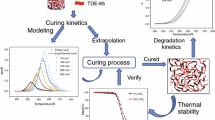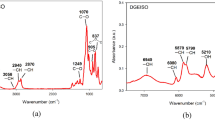Abstract
In this study, thermal properties and curing kinetics of composites based on epoxy resin and talc as safer bio-based filler were investigated by differential scanning calorimetry (DSC). The study revealed that the curing profiles of all epoxy composites with talc were slightly identical with that of neat epoxy. Initial curing temperatures and curing rates of all composites were lower than that of neat epoxy. The glass transition temperature (Tg) of the neat epoxy and its composites was also studied using DSC and found at (95, 94.4, 86.5, and 86.6 °C, for pure epoxy, epoxy/talc: 10%, 20%, and 30 wt%, respectively). Kinetic parameters such as activation energy (Eα), pre-exponential factor (A), and curing temperatures at four different heating rates (10, 15, 20, and 25 °C/min) were also evaluated by means of two isoconversional models, namely Kissinger and Ozawa methods. The results obtained by both models showed that the composites have smooth and single exothermic peak which occurs in the same temperature range correspond to that of neat epoxy as well as comparable kinetics parameters. The obtained activation energy values for curing of epoxy with different talc contents calculated by two methods were ranging from 50 to 65 kJ/mol., while the typical value of the neat epoxy resins is 45 kJ/mol. Furthermore, all curing enthalpy values of composites were (127–140 J/g) and lower per the normal range for curing enthalpy of neat epoxy systems (148 J/g). Finally, it was proved that the incorporation of talc in epoxy resin allows manufacturing low-cost composite with acceptable thermal and curing properties.









Similar content being viewed by others
References
Baroncini EA, Yadav SK, Palmese GR, Stanzione JF (2016) Recent advances in bio-based epoxy resinsand bio-based curing agents. J Appl Polym Sci 113:44103. https://doi.org/10.1002/app.44103
Salasinska K, Barczewski M, Gorny R, Klozinski A (2018) Evaluation of highly filled epoxy composites modified with walnut shell waste filler. Polym Bull 75:2511–2528
Shah DU (2013) Developing plant fiber composites for structural applications by optimizing composite parameters: a critical review. J Mater Sci 48:6083–6107. https://doi.org/10.1007/s10853-013-7458-7
Mohanty AK, Misra M, Drzal LT (2002) Sustainable bio-composites from renewable resources: opportunities and challenges in the green materials world. J Polym Environ 10:19–26
Auvergne R, Caillol S, David G, Boutevin B, Pascault JP (2014) Bio-based thermosetting epoxy: present and future. Chem Rev 114:1082–1115
Wang K, Chen L, Wu JS, Toh ML, He CB, Yee AF (2005) Epoxy nanocomposites with highly exfoliated clay: mechanical properties and fracture mechanisms. Macromolecules 38:788–800
Camargo PHC, Satyanarayana KG, Wypych F (2009) Nanocomposites: synthesis, structure, properties and new application opportunities. Mater Res 12:1–39
Sprenger S, Kothmann MH, Altstaedt V (2014) Carbon fiber reinforced composites using an epoxy resin matrix modified with reactive liquid rubber and silica nanoparticles. Compos Sci Technol 105:86–95. https://doi.org/10.1016/j.compscitech.2014.10.003
Hsieh TH, Kinloch AJ, Masania K, Taylor AC, Sprenger S (2010) The mechanisms and mechanics of the toughening of epoxy polymers modified with silica nanoparticles. Polymer 51:6284–6294
Mohammad R, Saeb MG, Hadi R, Hossein AK, Frank S, Farhood N, Vahabodin G, Poornima VP, Debora P, Farzaneh HA, Krzysztof F (2017) Biowaste chicken eggshell powder as a potential cure modifier for epoxy/anhydride systems: competitiveness with terpolymer-modified calcium carbonate at low loading levels. RSC Adv 7:2218–2230. https://doi.org/10.1039/c6ra24772e
Shnawa HA (2021) Curing and thermal properties of tannin-based epoxy and its blends with commercial epoxy resin. Polym Bull 78:1925–1940
Jahani Y (2011) Comparison of the effect of mica and talc and chemical coupling on the rheology, morphology, and mechanical properties of polypropylene composites. Polym Adv Technol 22:942–950. https://doi.org/10.1002/pat.1600
Emi GB, Vesna R, Bojana OP (2013) The influence of talc content on the thermal and mechanical properties of thermoplastic polyurethane/polypropylene blends. J Elastom Plast 45(6):501–522. https://doi.org/10.1177/0095244312458602
Ammar O, Bouaziz Y, Haddar N, Mnif N (2017) Talc as reinforcing filler in polypropylene compounds: effect on morphology and mechanical properties. Polym Sci 3:1–7. https://doi.org/10.4172/2471-9935.100023
Maiti SN, Sharma KK (1992) Studies on polypropylene composites filled with talc particles. J Mater Sci 27:4605–4613
Fillon B, Thierry A, Lotz B, Wittmann JC (1994) Efficiency scale for polymer nucleating agents. J Therm Analy 42:721–731
Harris AM, Lee EC (2008) Improving mechanical performance of injection molded PLA by controlling crystallinity. J Appl Polym Sci 107:2246–2255
Jain S, Reddy MM, Mohanty AK, Misra M, Ghosh AK (2010) A new biodegradable flexible composite sheet from poly(lactic acid)/poly(ε-caprolactone) blends and micro-talc. Macromol Mater Eng 295:750–762. https://doi.org/10.1002/mame.201000063
Tuen SB, Hassan A, Abu Bakar A (2012) Mechanical properties of talc- and (calcium carbonate)-filled poly(vinyl chloride) hybrid composites. J Vinyl Addit Technol 18:76–86
Katiyar JK, Sinha SK, Kumar A (2016) Friction and wear durability study of epoxy-based polymer (SU-8) composite coatings with talc and graphite as fillers. Wear 362–363:199–208
Rajaei M, Wang DY, Bhattacharyya D (2017) Combined effects of ammonium polyphosphate and talc on the fire and mechanical properties of epoxy/glass fabric composites. Compos Part B Eng 113:381–390. https://doi.org/10.1016/j.compositesb.2017.01.039
Ning L, Yang L, Chao F, Gang L (2018) Epoxy acrylate modified by talc in three dimensional printing. Mater Res Express 5(8):085306. https://doi.org/10.1088/2053-1591/aad0df
Karasinski EN, Da Luz MG, Lepienski CM, Coelho LAF (2013) Nanostructured coating based on epoxy/metal oxides: kinetic curing and mechanical properties. Thermochim Acta 569:167–176
Zheng T, Wang X, Lu C, Zhang X, Ji Y, Bai C, Chen Y, Qiao Y (2019) Studies on curing kinetics and tensile properties of silica-filled phenolic amine/epoxy resin nanocomposite. Polymers 11:680. https://doi.org/10.3390/polym11040680
Hu J, Hao W, Xing L, Zhang J, Yang W, Chen L (2011) Isoconversional analysis of non-isothermal curing process of epoxy resin/epoxide polyhedral oligomeric silsesquioxane composites. Polym Test 30:349–355
Safety datasheet of NITOPRIME 25 and HARDENER 25, fosroc limited (2014). http://www.fosroc.com/assets/productSafetysheets/Nitoprime-25-hardener.pdf. Accessed at 12/9/2021.
Kissinger HE (1956) Variation of peak temperature with heating rate in differential thermal analysis. J Res Natl Bureau Stand 57:217–221
Ozawa T (1970) Kinetic analysis of derivative curves in thermal analysis. J Therm Anal Calorim 2:301–324
Onuchin DV, Sirotin IS, Pavlova GA, Filatov SN, Kireev VV, Kerber ML, Gorbunova IY (2018) Features of curing of a diane epoxy oligomer modified with epoxyphosphazene. Polym Sci Ser B 60:182–187
Xu WB, Bao SP, Shen SJ, Hang GP, He PS (2003) Curing kinetics of epoxy resin–imidazole–organic montmorillonite nanocomposites determined by differential scanning calorimetry. J Appl Polym Sci 88:2932–2941
Fei X, Zhao F, Wei W, Luo J, Chen M, Liu X (2016) Tannic acid as a bio-based modifier of epoxy/anhydride thermosets. Polymers 8:314. https://doi.org/10.3390/polym8090314
Chen JS, Poliks MD, Ober CK, Zhang Y, Wiesner U, Giannelis E (2002) Study of the interlayer expansion mechanism and thermal-mechanical properties of surface-initiated epoxy nanocomposites. Polymer 43:4895–4904
Wang K, Wu J, Chen L, He C, Toh M (2004) Mechanical properties and fracture behavior of epoxy nanocomposites with highly exfoliated pristine clay. In ANTEC conference proceedings. Chicago, USA, pp 1820–1824
Auad ML, Nutt SR, Pettarin V, Frontini PM (2007) Synthesis and properties of epoxy-phenolic clay nanocomposites. Express Polym Lett 1:629–639
Cai H, Li P, Sui G, Yu Y, Li G, Yang X, Ryu S (2008) Curing kinetics study of epoxy resin/flexible amine toughness systems by dynamic and isothermal DSC. Thermochim Acta 473:101–105
Khezri K, Haddadi-Asl V, Roghani-Mamaqani H, Salami-Kalajahi M (2012) Nanoclay encapsulated polystyrene microspheres by reverse atom transfer radical polymerization. Polym Compos 33:990–998
Friedman HL (1964) Kinetics of thermal degradation of char-forming plastics from thermogravimetry. Application to a phenolic plastic. J Polym Sci Part C Polym Symp 6:183–195
Vyazovkin S (2002) Is the Kissinger equation applicable to the processes that occur on cooling? Macromol Rapid Commun 23:771–775
Costa ML, Paradini LC, Rezende MC (2005) Influence of aromatic amine hardeners in the cure kinetics of an epoxy resin used in advanced composites. Mater Res 8:65–70
Perrin FX, Nguyen TMH, Vernet JL (2007) Kinetic analysis of isothermal and nonisothermal epoxy-amine cures by model-free isoconversional methods. Macromol Chem Phys 208:718–729
Montserrat S, Roman F, Colomer P (2003) Vitrification and dielectric relaxation during the isothermal curing of an epoxy–amine resin. Polymer 44:101–114
Verchère D, Sautereau H, Pascault JP, Riccardi CC, Moschiar SM, Williams RJJ (1990) Buildup of epoxy cycloaliphatic amine networks. Kinetics, vitrification, and gelation. Macromolecules 23:725–731
Malek J (1992) The kinetic analysis of non-isothermal data. Thermochim Acta 200:257–269
Deng Y, Martin GC (1994) Diffusion and diffusion-controlled kinetics during epoxy-amine cure. Macromolecules 27:5147–5153
Haddadi SA, Kardar P, Abbasi F, Mahdavian M (2017) Effects of nano-silica and boron carbide on the curing kinetics of resole resin. J Therm Anal Calorim 128:1217–1226. https://doi.org/10.1007/s10973-016-5951-3
Yousefi A, Lafleur PG, Gauvin R (1997) Kinetic studies of thermoset cure reactions: a review. Polym Compos 18:157–168
Acknowledgements
The author gratefully acknowledges Dr. Mohamed Ali Jabber, the head of polymer research center, university of Basrah and also Dr. Ziyad Tareq Al-maliki, a researcher at this institute for their help during carried out this project especially for DSC analysis.
Author information
Authors and Affiliations
Corresponding author
Additional information
Publisher's Note
Springer Nature remains neutral with regard to jurisdictional claims in published maps and institutional affiliations.
Rights and permissions
About this article
Cite this article
Shnawa, H.A. Studies on thermal properties and curing kinetics of talc-filled epoxy resin composite using differential scanning calorimetry. Polym. Bull. 79, 11461–11478 (2022). https://doi.org/10.1007/s00289-021-04012-1
Received:
Revised:
Accepted:
Published:
Issue Date:
DOI: https://doi.org/10.1007/s00289-021-04012-1




